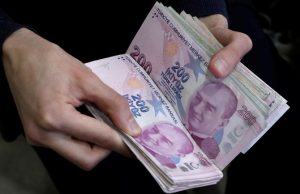The exchange rate between the Turkish lira and the U.S. dollar has been a critical indicator for investors, economists, and policymakers. The “Turkish Lira to USD Trend” not only reflects the economic health of Turkey but also has significant implications for global markets. This article will explore the historical context of this exchange rate, analyze the current trend, and provide predictions for the future. We will also examine how this trend is influencing global markets and what investors can expect moving forward.
Historical Context of the Turkish Lira to USD Trend

Early Years of the Turkish Lira
The Turkish lira has a long history, with its origins dating back to the Ottoman Empire. However, the modern Turkish lira, as we know it today, was introduced in 1923 following the establishment of the Republic of Turkey.
Initial Stability and Subsequent Decline:
- Post-War Era: In the early decades of the Turkish Republic, the lira maintained relative stability against the U.S. dollar. However, as Turkey’s economy began to industrialize and globalize, the lira started to experience fluctuations.
- 1970s and 1980s: The 1970s marked the beginning of a significant decline in the lira’s value, driven by high inflation, political instability, and economic mismanagement. This period set the stage for the long-term “Turkish Lira to USD Trend” that would see the lira weaken significantly over the coming decades.
The Impact of Inflation and Economic Crises
Turkey’s economic history has been marred by periods of high inflation and financial crises, both of which have played a critical role in shaping the “Turkish Lira to USD Trend.”
Hyperinflation in the 1990s:
- Economic Instability: The 1990s were characterized by hyperinflation in Turkey, with annual inflation rates often exceeding 100%. This period saw the lira lose significant value against the U.S. dollar, contributing to a long-term downtrend.
- Financial Crises: Turkey experienced several financial crises during this period, including the 1994 crisis, which resulted in a sharp devaluation of the lira.
The 2001 Financial Crisis:
- Major Devaluation: The 2001 financial crisis in Turkey was a turning point in the “Turkish Lira to USD Trend.” The crisis led to a major devaluation of the lira and prompted the government to implement significant economic reforms.
- Introduction of the New Turkish Lira: In 2005, Turkey introduced the New Turkish Lira (TRY) by removing six zeros from the old currency. This revaluation was part of a broader effort to stabilize the lira and improve investor confidence.
Current Analysis of the Turkish Lira to USD Trend

Economic Fundamentals and Their Impact
The “Turkish Lira to USD Trend” in recent years has been heavily influenced by Turkey’s economic fundamentals, including inflation rates, interest rates, and external debt levels.
Inflation and Monetary Policy:
- Persistent Inflation: Turkey has struggled with high inflation in recent years, which has put downward pressure on the lira. The Central Bank of the Republic of Turkey (CBRT) has been forced to implement tight monetary policies to combat inflation, leading to fluctuations in the exchange rate.
- Interest Rate Decisions: The CBRT’s interest rate decisions have been a key driver of the “Turkish Lira to USD Trend.” Aggressive rate cuts aimed at stimulating economic growth have often led to short-term depreciation of the lira.
External Debt and Trade Imbalances:
- High External Debt: Turkey’s reliance on external debt, particularly in foreign currencies, has exacerbated the lira’s vulnerability to global market conditions. A strong U.S. dollar and rising global interest rates have made it more expensive for Turkey to service its debt, contributing to lira depreciation.
- Trade Deficits: Persistent trade deficits have also contributed to the weakening of the lira. Turkey’s dependence on imported goods, particularly energy, has led to a negative balance of payments, putting further pressure on the exchange rate.
Political and Geopolitical Influences
Political and geopolitical factors have played a significant role in shaping the “Turkish Lira to USD Trend.” Domestic political stability and Turkey’s relations with key global powers are critical determinants of the lira’s value.
Domestic Political Landscape:
- Elections and Policy Shifts: Political events, such as elections and changes in government policies, have a direct impact on investor confidence and the lira’s value. Uncertainty surrounding these events often leads to increased volatility in the “Turkish Lira to USD Trend.”
- Government Interventions: The Turkish government’s interventions in the economy, including pressure on the central bank to lower interest rates, have at times led to sharp declines in the lira’s value.
Geopolitical Tensions:
- Regional Conflicts: Turkey’s involvement in regional conflicts, particularly in the Middle East, has introduced geopolitical risks that contribute to lira volatility. These tensions can lead to sudden shifts in the “Turkish Lira to USD Trend.”
- Relations with the U.S. and EU: Turkey’s diplomatic relations with the United States and the European Union also play a crucial role. Sanctions, trade disputes, or diplomatic conflicts with these major economies can lead to significant movements in the exchange rate.
How the Turkish Lira to USD Trend is Shaping Global Markets
Impact on Emerging Markets

The “Turkish Lira to USD Trend” has broader implications for emerging markets, as Turkey is often seen as a bellwether for other developing economies. Investors closely monitor the lira’s performance as an indicator of broader trends in emerging markets.
Investor Sentiment:
- Risk Appetite: The lira’s volatility can influence global investor sentiment towards emerging markets. A weakening lira may lead to a broader risk-off sentiment, with investors pulling out of other emerging markets in favor of safer assets.
- Contagion Risk: There is a risk that a sharp decline in the lira could lead to contagion, with other emerging market currencies coming under pressure as investors reassess their risk exposure.
Capital Flows:
- Impact on Capital Inflows: A weak lira can deter foreign investment in Turkey, leading to reduced capital inflows. This, in turn, can impact other emerging markets that rely on similar capital flows.
- Currency Depreciation: The “Turkish Lira to USD Trend” can also influence the exchange rates of other emerging market currencies. A significant depreciation of the lira can lead to similar trends in other countries with similar economic profiles.
Influence on Global Trade
The exchange rate between the Turkish lira and the U.S. dollar has implications for global trade, particularly for countries that have strong trade ties with Turkey.
Export Competitiveness:
- Cheaper Exports: A weaker lira makes Turkish exports more competitive on the global market, which can boost Turkey’s trade balance. This can lead to shifts in global trade dynamics, particularly in industries where Turkey is a major player, such as textiles and automotive.
- Impact on Import Costs: On the flip side, a weaker lira makes imports more expensive, which can lead to higher costs for Turkish businesses and consumers. This can reduce demand for imported goods and impact global suppliers.
Global Supply Chains:
- Supply Chain Disruptions: The “Turkish Lira to USD Trend” can also impact global supply chains, particularly in industries where Turkey is a key supplier. Currency volatility can lead to disruptions in production and delivery schedules, affecting global markets.
- Trade Partnerships: Changes in the lira’s value can influence Turkey’s trade partnerships. For example, a weaker lira may lead Turkey to seek closer trade ties with countries that offer more favorable terms, potentially reshaping global trade alliances.
Predictions for the Future of the Turkish Lira to USD Trend
Short-Term Forecast
In the short term, the “Turkish Lira to USD Trend” is expected to remain volatile due to ongoing economic and political uncertainties. Several factors will likely influence the trend over the next few months.
Monetary Policy Outlook:
- Interest Rate Adjustments: The CBRT’s interest rate decisions will continue to be a major driver of short-term movements in the lira. Any unexpected rate cuts or hikes could lead to sharp fluctuations in the exchange rate.
- Inflation Control: Efforts to control inflation will be critical. If inflation continues to rise, it could lead to further depreciation of the lira against the U.S. dollar.
Political Developments:
- Election Outcomes: Upcoming elections or political events could lead to increased volatility in the “Turkish Lira to USD Trend.” Investors will be closely watching for any signs of policy shifts that could impact the lira’s value.
- Geopolitical Risks: Ongoing geopolitical tensions, particularly in the Middle East, will continue to pose risks to the lira’s stability.
Medium to Long-Term Forecast
In the medium to long term, the “Turkish Lira to USD Trend” will depend on Turkey’s ability to implement sustainable economic policies and manage its geopolitical risks.
Economic Reforms:

- Structural Reforms: Successful implementation of structural economic reforms, including measures to reduce external debt and control inflation, could lead to a more stable lira over time.
- Diversification of the Economy: Efforts to diversify Turkey’s economy and reduceits reliance on volatile sectors like energy imports could also contribute to long-term stability in the “Turkish Lira to USD Trend.” Diversifying the economy by strengthening sectors like technology, agriculture, and manufacturing may reduce the country’s vulnerability to external shocks and currency fluctuations.
Global Economic Conditions:
- U.S. Monetary Policy: The U.S. Federal Reserve’s monetary policy will continue to have a significant impact on the “Turkish Lira to USD Trend.” If the Fed continues to raise interest rates to combat inflation, the U.S. dollar may strengthen further, putting additional pressure on the lira.
- Global Market Sentiment: The overall sentiment in global markets, particularly towards emerging markets, will influence the long-term trend. If global investors perceive emerging markets as high-risk due to geopolitical instability or economic challenges, the lira may continue to face downward pressure.
Turkey’s Geopolitical Strategy:
- Regional Alliances: Turkey’s geopolitical strategy, including its relations with key global powers, will play a crucial role in shaping the future “Turkish Lira to USD Trend.” If Turkey can strengthen its alliances and avoid major conflicts, it may help stabilize the lira.
- EU and U.S. Relations: Turkey’s relations with the European Union and the United States will remain pivotal. A stable and positive relationship with these economic giants could bolster investor confidence and support a more favorable exchange rate.
Investment Strategies in Response to the Turkish Lira to USD Trend
Hedging Against Currency Risk
For investors exposed to the “Turkish Lira to USD Trend,” hedging strategies can be essential to managing currency risk.
Forward Contracts:
- Locking in Exchange Rates: Forward contracts allow investors to lock in an exchange rate for a future date, providing protection against adverse movements in the “Turkish Lira to USD Trend.” This can be particularly useful for businesses with predictable cash flows in foreign currencies.
Options and Derivatives:
- Flexibility in Hedging: Currency options and derivatives offer more flexibility than forward contracts. Investors can use options to hedge against unfavorable currency movements while still benefiting from favorable trends if the lira appreciates.
Diversification of Investments
Investors can also mitigate the risks associated with “Turkish Lira to USD Trend” by diversifying their portfolios.
Emerging Markets Exposure:
- Spreading Risk: Diversifying across multiple emerging markets can reduce the impact of a decline in the Turkish lira. By spreading investments across countries with different economic profiles, investors can lower their overall risk.
- Sector Diversification: Within Turkey, investing in a range of sectors—such as technology, agriculture, and tourism—can also help reduce exposure to lira volatility. Sectors that are less sensitive to currency fluctuations may provide more stable returns.
Global Assets:

Non-Turkish Assets: Investing in global assets, such as U.S. stocks, European bonds, or commodities, can provide a buffer against the impact of the “Turkish Lira to USD Trend.” These assets are typically less correlated with the lira’s movements and can offer stability during periods of currency volatility.
-
Conclusion
The “Turkish Lira to USD Trend” is a complex and dynamic aspect of global finance that has far-reaching implications for both domestic and international markets. Understanding the historical context, current factors, and future predictions of this trend is essential for investors, policymakers, and economists alike.
While the lira has faced significant challenges due to inflation, external debt, and geopolitical risks, there are also opportunities for investors who can navigate these complexities. By employing strategies such as hedging, diversification, and staying informed about economic and political developments, investors can manage their exposure to the “Turkish Lira to USD Trend” and potentially benefit from the unique opportunities presented by this market.
As global markets continue to evolve, the Turkish lira’s relationship with the U.S. dollar will remain a critical factor in shaping investment strategies and economic outcomes. Whether you are an investor looking to capitalize on emerging market trends or a business managing foreign exchange risk, understanding the “Turkish Lira to USD Trend” will be key to making informed decisions in the years ahead
Navigating Turkish Lira Volatility: Forecasts and Strategies for Investors
Investment in Turkey for Foreigners: Legal and Financial Considerations

